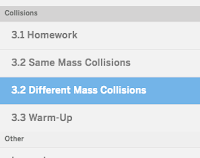Standards:
MS-PS2-2: Plan an investigation
to
provide
evidence
that
the
change
in
an
object’s
motion depends on
the sum of the
forces on
the
object
and
the
mass
of
the
object.
Objectives
· 1. Students will explain that Newton's 3rd Law demonstrates that forces exist in pairs that are equal in size an opposite in direction by completing the Newton's 3rd Law Cornell Notes with a 3 or better.
1. Do Now: Momentum and Collisions Pre-Quiz
Independent
1. Watch THIS VIDEO and take the Momentum Cornell Notes:
Vocabulary
Momentum
Stationary
Conservation of Momentum
Closed system
Collision
Initial Velocity
Initial Momentum
Final Momentum
Total Momentum
Questions
1. What is the first key fact listed in the video?
2. Why do objects that are not moving have a momentum equal to zero?
3. How do we calculate momentum?
4. What does the letter "p" stand for in the momentum formula?
5. What are the units for momentum?
6. A car has a mass of 1000kg and is not moving. What is its momentum?
7. A car has a mass of 1000kg and is moving at a velocity of 20 m/s.
Calculate the momentum of the car.
8. Ms. Garrett's hand has a mass of 1kg and is traveling with a velocity of 6m/s
towards Justin Bieber's face. What is the momentum of her hand?
9. Look at the formula
m1v1initial + m2v2initial = m1v1final + m2v2final.
This is the formula where we can calculate how momentum is conserved in a
closed system with 2 objects. Explain what you think the left side of the formula
means, and what the right side of the formula means. What does each variable mean?
10. Draw and explain the example of the van and the car where momentum was
conserved.
11. Explain why momentum is conserved, and why the total momentum of the
system is 0 kgm/s in the cannon example, even though both objects begin as
stationary and end as moving.
Summary: Today I learned.....
Cornell Notes Criteria for success:
- Notes are set up in Cornell Note format
- All vocabulary is defined in student friendly language (not copied from google)
- 8 or more of the questions are answered fully AND correctly, using information and examples from the video
- A summary of what was learned is at the bottom, using 2-3 complete sentences.
4= All success criteria is met
3= 3/4 success criteria is met
2= 2/4 success criteria is met
NP = none of the success criteria is met
Optional (ONLY AFTER YOU ARE FINISHED!!!!)
1. Watch THIS BILL NYE on Momentum
2. Play with this PhEt simulation to explore how changing masses affect the amount of force needed to move an object
2. Play the NET FORCE GAME and try to beat a score of 6 (the highest anyone has scored has been 19)
3. Watch THIS VIDEO on roller coaster Physics
4. Play the roller coaster building game


